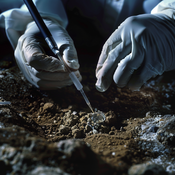Alexandrium

|
This article or section is a work in progress. The information below may be incomplete, outdated, or subject to change. |
Alexandrium is a novel element discovered in the Region of Alduria, within the Federation of Nouvelle Alexandrie. Identified in 1729 AN by a distinguished scientific team from the Royal University of Parap, this element arose from the unique geological and nuclear conditions prevalent in the aftermath of the Babkhan Holocaust on the continent of Eura. The creation of Alexandrium under such severe conditions has resulted in its unparalleled properties, heralding a potential revolution in energy production, materials science, and beyond.
Characteristics
Physical Properties
Alexandrium is noted for its prismatic luster and crystalline structures that form complex geometric patterns, capable of refracting light into a spectrum of vibrant colors. This element's density is significantly higher than traditional heavy metals, including lead, adding to its distinctiveness. Possessing an exceptionally high melting point, Alexandrium can withstand extreme heat and resist corrosion, which makes it a prime candidate for use in challenging environments such as aerospace, deep-sea exploration, and high-temperature reactors. Its energy density is extraordinary and it showcases exceptional stability when exposed to radiation, with potential applications in energy storage and generation that could redefine modern technology.
Chemical Properties and Compounds
Chemically, Alexandrium forms superconductive compounds at temperatures that are considerably higher than those of current superconductors. This trait indicates a breakthrough in electrical energy transmission and the potential to dramatically reduce current energy losses. The compounds of Alexandrium are also noted for their remarkable chemical stability, suggesting their suitability for creating durable materials and protective coatings that can endure extreme environmental conditions.
Isotopes
The isotopic variety of Alexandrium includes several isotopes, each with distinct half-lives and potential applications. The most stable isotope, Alexandrium-239, possesses a half-life exceeding 10,000 years, positioning it as a virtually inexhaustible energy source for applications requiring long-term energy autonomy, such as interstellar travel. Its stability also offers intriguing possibilities for sustainable energy and advanced medical treatments leveraging its controlled radioactive properties.
Discovery
The revelation of Alexandrium on the periodic table is attributed to the leading-edge explorations conducted by the scientific coalition at the Royal University of Parap in conjunction with the National Research and Development Corporation. In the year 1729 AN, leveraging the sophisticated techniques of spectroscopic analysis and employing the high-energy particle collision method, the collaborative research teams achieved a breakthrough. They meticulously analyzed soil samples collected from the radiation-impacted zones of present-day Alduria, Nouvelle Alexandrie, which still bears the scars of nuclear fallout caused by the Babkhan Holocaust in 1589 AN. It was within these samples that they identified the unique atomic signature of Alexandrium, an element previously unseen and unrecorded in scientific literature.
The discovery process involved isolating the element from a complex matrix of soil components altered by intense radioactive exposure. The research teams utilized a series of high-resolution spectral lines to pinpoint the presence of Alexandrium amidst a cacophony of signals arising from other elements and compounds in the soil. The definitive identification was corroborated through the application of high-energy particle collisions, which allowed for the observation of Alexandrium's characteristic decay patterns and atomic interactions.
Confirmed deposits
The discovery of Alexandrium has led to the identification of significant deposits across Eura, with Alduria alone boasting substantial amounts. The most prominent deposits have been located in the following areas:
| Location | Nation | Updated Deposit (metric tons) | Estimated Value of Entire Deposit |
|---|---|---|---|
| Piriya, Alduria | 80,000 | €137,840,000,000 | |
| Sana'Ri, Alduria | 203,765 | €351,273,495,000 | |
| Bathshahr, Alduria | 296,109 | €510,243,927,000 | |
| Susa, Alduria | 188,123 | €324,247,929,000 | |
| Alcala, Alduria | 564,424 | €972,578,392,000 | |
| Ajinkeliç, Alduria | 90,000 | €155,070,000,000 | |
| Aqabah, Molivadia | 250,000 | €430,750,000,000 | |
| Nivardom, Molivadia | 130,000 | €223,990,000,000 | |
| Zinjibar, Norasht | 338,036 | €582,394,012,000 |
The total proven and confirmed deposits across these locations now amount to 2,041,457 metric tons of Alexandrium. This revision significantly increases the previous estimates[1] and underscores the vast economic potential these deposits represent for Nouvelle Alexandrie, Constancia, and the Suren Confederacy.
The enormous value of these deposits, calculated at the benchmark price of €1,723 per gram, highlights the rarity and significance of Alexandrium.
Potential Applications
Energy
Materials
Medicine
Extraction
Methods
Controversies
Environmental Concerns
Health Concerns
Regulation and Policy
Economic Impact
Future Research
See also
- Economy of Nouvelle Alexandrie
- Royal University of Parap
- National Research and Development Corporation

